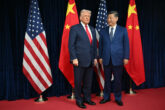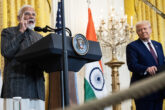November 03, 2017
The Quiet Rivalry Between China and Russia
China’s “One Belt, One Road” initiative, an economic expansion plan that follows the trade routes of the medieval Tang and Yuan dynasties across Eurasia, is overly ambitious because, like all grand strategies, it is aspirational. Yet the future of Eurasia is written into its design.
This new Silk Road serves several goals of China’s leaders, who are intent on making their country a full-fledged superpower. It is a branding operation for many of the roads, bridges, pipelines and railroads that China has already built, linking it with the former-Soviet-controlled countries of energy-rich Central Asia. In the process, One Belt, One Road seeks to develop — and at the same time surround — the Muslim region of China that abuts Central Asia.
Further westward, China intends to create an organic alliance with Iran, a state that because of its immense size, location and population, as well as its long imperial tradition, functions as the fulcrum for the Middle East and Central Asia.
The larger Chinese goal is to dominate Eurasia, which means relegating Russia to a second-tier power.
China and Russia share a land border of more than 2,600 miles, an interminable stretch of birch forest separating mainly the Russian Far East from Chinese Manchuria, whose particulars were formally agreed upon only in the last decade. In 1969, the dispatch of about 30 Soviet divisions to this border, and China’s deployment of 59 divisions in response, deepened the Chinese-Soviet split and allowed for President Richard Nixon’s opening to China and his détente with the Soviet Union.
Read the full essay in The New York Times.
More from CNAS
-
Indo-Pacific Security / Energy, Economics & Security
How to Win the Economic War with ChinaTrump's approach to China has run aground, giving Beijing unprecedented advantage in the economic conflict....
By Edward Fishman & Julian Gewirtz
-
America’s Self-Loathing Is a Losing Hand
This article was originally published in The Washington Post.Around 10 years ago, the United States began a historic shift in its grand strategy toward China, abandoning the b...
By David Feith
-
Indo-Pacific Security / Energy, Economics & Security / Technology & National Security
Selling AI Chips Won’t Keep China Hooked on U.S. TechnologyU.S. policy should not rest on the illusion that selling chips can trap China inside the American tech ecosystem....
By Janet Egan
-
Will New Delhi-Beijing Move Beyond Friction Points? | Ex-White Official On India-China Reset
Prime Minister Narendra Modi on Friday said that India and China, as two major economies, must work together to bring stability to the global economic order. NDTV's Gaurie Dwi...
By Lisa Curtis




